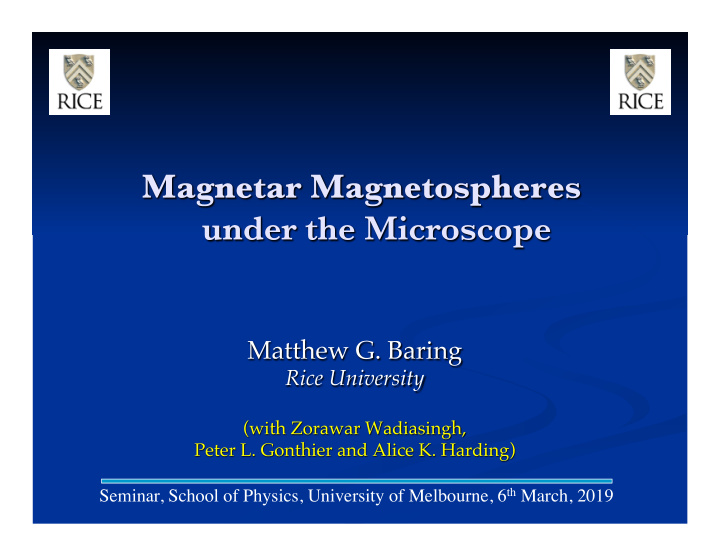



Seminar, School of Physics, University of Melbourne, 6 th March, 2019
Isolated Pulsar P-Pdot Diagram: Fermi era 10 13 Gauss • The phase-space plot for the pulsar population. Dipole field strength B p inferences scale as the observable (P Pdot) 1/2 . Nearly 30 magnetars.
SGR J1550 − 5418 Bursts � January 2009 • Top : joint spectra with two BB fit and residuals; • Bottom : Light curves for GBM-NaI (top) and Swift XRT (bottom). • Lin et al. (ApJ, 2012)
Source: Kevin Hurley
Magnetars: Hard X-ray Tail Sources • INTEGRAL, RXTE, NuSTAR etc. have detected hard, non- thermal pulsed tails in nine magnetars (see Table). In all of these, the differential spectra above 20 keV are extremely flat: – 1E 1841-045 (Kuiper, Hermsen & Mendez 2004) has a power-law energy index of Γ h =0.94 between around 20 keV and 150 keV; – 4U 0142+61 displays an index of Γ h =0.2 in the 20 - 50 keV band, with a steepening at higher energies (Kuiper et al. 2006; den Hartog et al. 2008a); – RXS J1708-4009 has a Γ h =0.88 tail in 20-150 keV (detailed in Kuiper et al. 2006; den Hartog et al. 2008b) - see the spectrum on subsequent page.
Den Hartog et al. (2008)
Enoto et al. (2010) Hard X-ray Tails are Common in Magnetars • Classical X-ray band 1-10 keV for SGRs and AXPs from Chandra + XMM observations; • INTEGRAL-IBIS/ISGRI spectra in 20-100 keV band has a range of indices , with E - Γ for Γ =0.4-1.9. Similar for NuSTAR. • There is some minor variability of index Γ on long timescales e.g. SGR 1806-20 . • Not all tail flux is pulsed.
Magnetars with Hard X-ray Tails Tail index From Wadiasingh et al. (2019, in prep.)
Hard X-ray Tail Modeling � Preferred hypothesis is the resonant Compton upscattering model (Baring & Harding 2007; Fernandez & Thomson 2007; Nobili, Turolla & Zane, 2008; Baring, Wadiasingh & Gonthier 2011, Beloborodov 2013, and later papers) : � non-thermal hard X-rays are spawned by inverse Compton heating of soft, atmospheric photons by relativistic electrons. � The electrons are presumed to be accelerated probably along closed field lines, by static electric potentials, or dynamic ones associated with large scale currents and twists in the magnetic field (e.g. Thompson & Beloborodov 2005; Parfrey et al. 2013). � Currents/charge densities along closed field lines far exceed Goldreich-Julian values; � The putative locale of scattering is the inner magnetosphere, within 1-10 stellar radii of the surface.
Resonant Compton Cooling Geometry � Baring, Wadiasingh & Gonthier (2011) computed resonant Compton cooling rates for hemispherical soft photons in magnetospheric geometry.
Resonant Thomson Cross Section Surface emission domain Cyclotron energy • Cross section of O-mode (||) is strongly suppressed below cyclotron frequency ω B for photons beamed almost along B ; same is true for X-mode (Canuto et al. 1971).
Resonant Compton Cross Section: QED B=1 => B=4.41 x 10 13 G Gonthier et al. 2000 � Illustrated for photon propagation along B ; � In magnetar fields, cross section declines due to Klein-Nishina reductions; � Resonance at cyclotron frequency eB/m e c; � Below resonance, l=0 provides contribution; � In resonance, cyclotron decay width truncates divergence.
Resonant Interaction Geometry • Meridional case: hardest emission comes from concentrated zones of almost radial extension, with B directed toward observer.
Resonant Compton Emission Hardness: Dipole Fields • Hard emission above 160 keV is blue or purple, softer emission is green or red. • For most viewing angles, X-rays above 160 keV come from a very small portion of the activated magnetosphere for the Lorentz factor and polar field chosen above.
Resonant Compton Spectra: � Viewing Oblique to Field Loops MeV • Off-meridional field loops, varying γ e : emission softer as Doppler boosting is less. (Wadiasingh et al., ApJ 2018). Guide spectrum: e.g. AXP 4U 0142+61.
Photon splitting Wadiasingh et al., attenuates X-mode ApJ, 2018. [arXiv:1712.09643] above ~50 keV. keV MeV • Perpendicular (X-mode) exceeds parallel (O-mode) polarization at the highest energies; photon splitting will mute this above 50 keV.
Intensity “Sky maps” above 50 keV Wadiasingh et al., in prep. Viewing angle α =15 o α =30 o Small toroidal volume Large toroidal volume Pulse phase
INTEGRAL/HEXTE Pulse Profiles of Magnetar J1708-4009
AMEGO Medium Energy � Gamma-ray Telescope Concept Credit: G. Younes
Spectro-Polarimetry Diagnostics Wadiasingh et al. in prep . • Phase-resolved model RICS spectra of a generic magnetar with arbitrary normalization overlaid on phase-averaged data for 4U 0412+61. The inverse Compton emission is highly polarized and spin-phase dependent.
Conclusions � Magnetic Compton upscattering can efficiently generate flat spectra like those seen in magnetar hard X-ray tails; � Spectra are strongly dependent on observer perspective, electron Lorentz factor and emission locale; � COMPTEL upper bounds can be met by large portions of the parameter space; they may also signal action of pair creation and photon splitting in attenuating spectra above 150 keV; � Prospect: can use pulse profiles to probe values of magnetic inclination angle α of magnetars; � Future agendas: Strong polarization signals above 50 keV prompt science agendas for Compton telescopes and polarimeters such as X- Calibur, AMEGO and e-ASTROGAM.
Recommend
More recommend